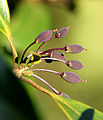Osmanthus heterophyllus
| Osmanthus heterophyllus | |
|---|---|

| |
| Hiiragi, in flower in Osaka | |
| Scientific classification | |
| Kingdom: | Plantae |
| Clade: | Tracheophytes |
| Clade: | Angiosperms |
| Clade: | Eudicots |
| Clade: | Asterids |
| Order: | Lamiales |
| Family: | Oleaceae |
| Genus: | Osmanthus |
| Species: | O. heterophyllus
|
| Binomial name | |
| Osmanthus heterophyllus (
P.S.Green | |
| Synonyms[1] | |
| |
Osmanthus heterophyllus (
Description
It is an
corolla, the corolla tube 1–2 mm long and the lobes 2.5–5 mm long; they are dioecious, with flowering in the autumn. The fruit is an ovoid dark purple drupe 1.5 cm long and 1 cm diameter, mature in the following summer about 9 months after flowering.[2][4][5][6]
-
flowers
-
fruits
-
leaf
Varieties
- Osmanthus heterophyllus var. heterophyllus. Leaves entire or spiny; flowers with short corolla lobes 2.5-3.5 mm long. Throughout the range of the species.
- Osmanthus heterophyllus var. bibracteatus (Hayata) P.S.Green. Leaves always entire; flowers with long corolla lobes 5 mm long. Endemic to Taiwan.
Nomenclature
Osmanthus is derived from Greek and means 'fragrant flower'.[7]
The scientific name heterophyllus, "different leaves", refers to the variation in leaf shape between spiny and entire. The common name holly osmanthus refers to the similarity in leaf shape to that of the holly (Ilex aquifolium), an example of convergent evolution with a common objective of deterring browsing; the two may be distinguished easily by the leaf arrangement, alternate in Ilex aquifolium and opposite in Osmanthus heterophyllus.
Cultivation

It is widely used as a
hedge plant.[6][8] Several cultivars have been selected for garden use, including 'Aureus', 'Goshiki', 'Purpureus', 'Rotundifolius', and 'Subangustatus'.[6] The cultivars 'Goshiki',[9] 'Variegatus'[10] and ‘Purple Shaft’ have gained the Royal Horticultural Society's Award of Garden Merit.[11]
The species has been hybridised in cultivation with Osmanthus fragrans; the resulting hybrid is named Osmanthus × fortunei Carr.[6]
Historical mentions
It is mentioned twice in the
References
- ^ "The Plant List".
- ^ a b c Flora of China: Osmanthus heterophyllus
- ^ "Osmanthus heterophyllus". Germplasm Resources Information Network. Agricultural Research Service, United States Department of Agriculture. Retrieved 2 January 2018.
- ^ Hata Labs Plant Ecology Laboratory: Osmanthus heterophyllus (in Japanese; google translation)
- ^ Rokko Mountain guide to trees: Osmanthus heterophyllus Archived 2005-05-25 at the Wayback Machine (in Japanese; google translation)
- ^ ISBN 0-333-47494-5.
- ISBN 9780521685535(paperback). pp 285, 410
- ^ JSTOR 594762.
- ^ "RHS Plant Selector - Osmanthus heterophyllus 'Goshiki'". Retrieved 14 September 2019.
- ^ "RHS Plant Selector - Osmanthus heterophyllus 'Variegatus'". Retrieved 25 May 2013.[permanent dead link]
- ^ "AGM Plants - Ornamental" (PDF). Royal Horticultural Society. 2018. p. 71. Retrieved 14 September 2019.
- ^ Kojiki. pp. vol. 2, sect. 26.
- ^ Chamberlain, Basil Hall (1932). Kojiki (2nd ed.). pp. 100.
- ^ Hosoda, Tominobu. Jindai seigo tokiwa-gusa.
- ^ Chamberlain, Basil Hall (1932). Kojiki (2nd ed.). pp. 22.
- ^ Matsuoka, Gentatsu (c. 1800). Honzo ikka gen.
Wikimedia Commons has media related to Osmanthus heterophyllus.



